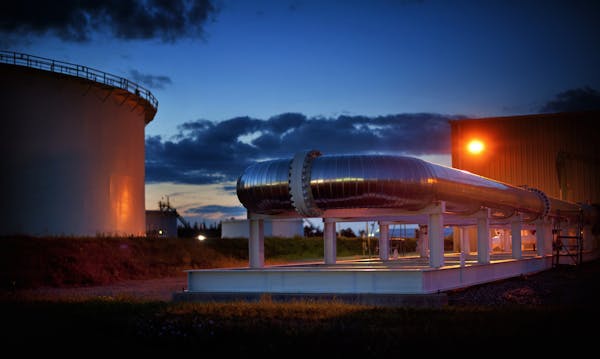A major expansion of a pipeline that carries Canadian heavy crude oil across Minnesota will get a closer look by state regulators.
As more than 40 anti-pipeline activists sat quietly in the audience, the Minnesota Public Utilities Commission unanimously voted Wednesday to authorize a contested-case review — similar to a trial — of the need to expand the carrying capacity of the 1,000-mile "Alberta Clipper" pipeline.
The line, owned by Enbridge Energy Co., runs from Hardisty, Alberta, across northern Minnesota and ends at an oil terminal in Superior, Wis.
"I am concerned about the potential for disaster," said Harry Miller, a retired Lutheran clergyman from Eagan who was among the MN350 activists seeking a review of the project.
MN350, which is loosely affiliated with the group fighting TransCanada's proposed Keystone XL pipeline, requested the inquiry, and was pleased with the decision. Now the group must raise money for a monthslong legal and evidentiary battle before an administrative law judge.
The fight in Minnesota is the latest effort by climate change activists to erect barriers to Canadian oil imports with the goal of curbing greenhouse gas emissions. The proposed Keystone XL line through Montana, South Dakota and Nebraska, is being fought on similar grounds.
Enbridge, which completed the Alberta Clipper in 2010, plans to invest $159 million in extra pumping stations to increase capacity by 40 percent to 800,000 barrels per day. In July, the company won PUC approval for a smaller capacity increase. The 36-inch pipeline was designed to operate at higher pressure to increase capacity, the company says.
In July, activists interrupted a PUC meeting to shout opposition to Enbridge's first expansion of the pipeline.
Enbridge spokeswoman Lorraine Little said the company will cooperate with the PUC and doesn't expect the process to delay the upgrade. The decision still rests with the PUC, which will act after the judge makes a recommendation.
In 2008, before the line was built, Enbridge prevailed in a similar process, convincing a judge and the PUC that the Alberta Clipper line was needed and would be safe. In one notable finding, Judge Eric Lipman concluded then that "transporting petroleum through a pipeline presents fewer safety risks for long-distance shipping than transporting petroleum by truck, rail, barge or tank ship."
2010 accident
Since that decision, Enbridge experienced the nation's worst on-land pipeline accident, in 2010, on another of its lines in Michigan. That rupture, which went undetected for hours, spilled 20,000 barrels of crude oil mostly into a river.
"It is a different time and people are more aware of these pipelines being built because of Keystone XL and a little bit more aware of tar sands crude," said Kate Jacobson, lead coordinator for MN350.
Jacobson said MN350 will argue that a majority of the new oil moving on the expanded pipeline won't benefit Minnesota or neighboring states. Too much of it, she said, is likely headed to the Gulf or other coasts for export as refined products.
Attorney Paul Blackburn, who has represented MN350, said the contested case could take six to 10 months. "We can make a much stronger case than was possible in 2007," said Blackburn.
The pipeline brings heavy oil from western Canada, where output is growing. The Canadian Association of Petroleum Producers in June projected that crude oil production in the Alberta oil sands region will nearly double to 5.2 million barrels per day by 2030.
Rail alternatives
Enbridge said expansion is needed because oil customers, including Twin Cities refineries, could be slapped with quotas as pipelines become oversubscribed.
The climate activists' strategy to stop pipelines may not stop Canadian oil imports. RBN Energy, an oil industry consulting firm in Houston, recently reported that at least seven unit train loading terminals could be operating in Alberta by 2016, with capacity to haul away 550,000 barrels per day on tank cars. In the Gulf Coast, refiners are building terminals to unload the oil. And North Dakota already ships most of its oil by rail.
Enbridge has defended the safety record of the Alberta Clipper line, saying the pipe's outer, anti-corrosion coating is better than that of the 1960s-era line that failed in Michigan. The company also says that hazardous material incidents on railroads are 33 times higher than on liquids pipelines, even though pipelines ship 16 percent more ton-miles than rail.
David Shaffer • 612-673-7090 • @ShafferStrib
United Airlines reports $124 million loss in a quarter marred by grounding of some Boeing planes

